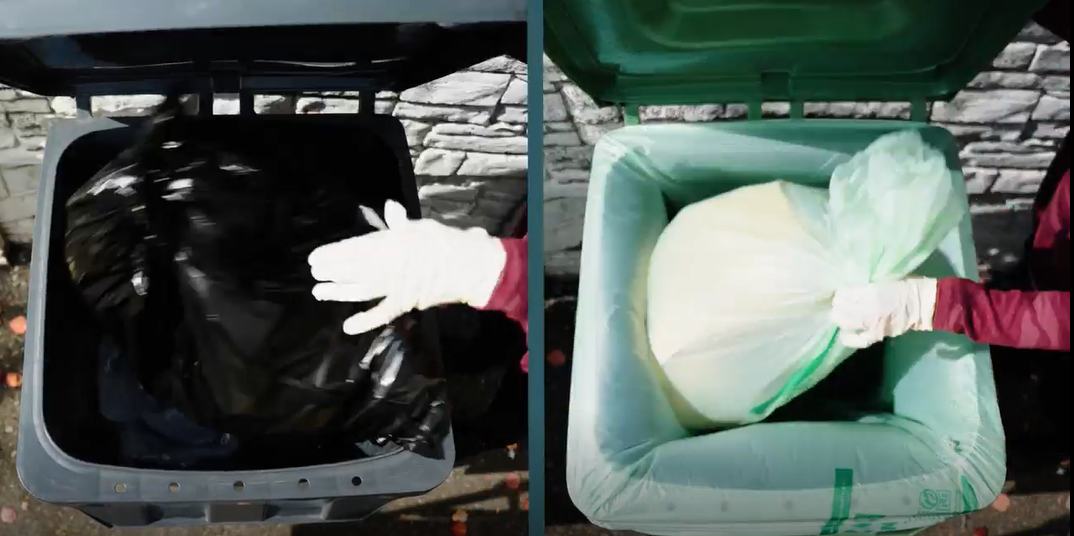What sparked this blog was a recent CBC news segment providing an update on how Canada’s single-use plastic ban is going and how compostables don’t hold up to what consumers believe they are meant to do. I was appalled to hear the phrase “most advanced facility” while watching how Toronto manages its organic waste stream.
Toronto processes 170 million kilograms of organic waste per year. In its current system, residents are allowed to use plastic and compostable bags in green bins. Once collected, plastics, compostable bags, and food scraps are chopped together and floated in water. The plastics and compostables rise to the top, are skimmed off, and sent directly to landfill.

The facility has advanced technology, but advancement without a true end-of-life pathway for regeneration misses the point. A system designed to skim compostables into the landfill is not circular. Food waste capture should return nutrients to the soil, not perpetuate a linear disposal model.
The real issue is not compostables themselves. It’s the lack of system design and standardization across provinces. Without an infrastructure that ensures compostables flow to soil, even the most “advanced” systems undermine their own purpose.
The Cradle-to-Cradle Framework
Cradle-to-Cradle (C2C), developed by William McDonough and Michael Braungart (2002), offers a useful framework for understanding where compostables fit. The first design protocol in C2C distinguishes between:
- Biological nutrients – materials like certified compostables that are safe to return to the soil.
- Technical nutrients – durable materials like metals or plastics that can cycle indefinitely through industrial systems.
The danger is in mixing the two, creating “monstrous hybrids” that can’t be properly recovered. Compostables, when designed and certified correctly, are meant to be biological nutrients—returning carbon and minerals to the soil, closing the loop on food waste, and reducing methane emissions from landfills.
This is eco-effectiveness in practice. Rather than making the current system “less bad,” compostables represent a redesign where waste equals food.
Compostables in Practice
The CBC segment featured the claim that industrial composters “don’t exist at scale anywhere.” This is misleading. Across North America, many facilities already accept and process compostables successfully. Ones that I have toured firsthand like:
- CompostNow in Atlanta demonstrates how source separation and proper handling allow compostables to flow into healthy soil systems.
- Napa Recycling in California integrates food scraps and compostable packaging into large-scale composting programs.
Hear directly from composters themselves in this *BioCycle commentary on why they accept compostable packaging and serviceware.* Their perspective shows that, when supported by the right systems, compostables are not an obstacle, they are a critical enabler of food waste diversion.
Designing for Soil
As William McDonough explains in Carbon Is Not the Enemy, soil is where carbon belongs. Healthy soils cycle carbon in ways that nourish plants, stabilize ecosystems, and balance the climate.
If our waste systems were designed with soil health in mind, compostables would not be treated as contaminants. They would be recognized as biological nutrients, tools that support waste haulers, custodial staff, and residents of dense urban centers in keeping food waste out of landfills and in returning carbon back to the earth.

Moving Forward
The path forward is not abandoning compostables. It is building systems that allow them to succeed. That requires:
- Standardization across provinces and municipalities, so composting systems align nationally.
- End-of-life planning that puts regeneration and soil health at the center.
- Practical tools like compostable liners that make food waste diversion accessible and effective for haulers, custodial staff, and households.
📢 Learn More: If you want to understand the rigorous standards behind compostables, join the upcoming session:
Inside BPI Certification: The Process Behind Compostable Packaging Approval
📅 October 15, 2025 | 🕛 12PM EST
This unique opportunity will walk through the certification process, from lab testing to data review, and highlight how scientists ensure that products meet strict compostability standards.
Conclusion
It is time to stop blaming compostables and start designing systems that reflect their purpose. Compostables are one of the few tools we have that bridge the gap between waste capture and soil regeneration. With proper infrastructure, they embody the very principle of Cradle-to-Cradle: waste equals food.
Let’s design for soil, not landfills.

